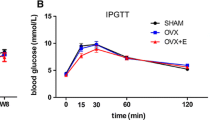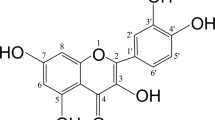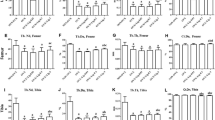Abstract
Introduction
Menopause can lead to osteoporosis, which is characterized by destruction of bone microstructure, poor mechanical properties, and prone to fracture. LIPUS can effectively promote bone formation and fracture healing. MSTN is a transforming growth factor-β family member that acts as a negative regulator of skeletal muscle growth. A MSTN deficiency also has a positive effect on bone formation. However, whether LIPUS could inhibit bone loss and promote healing of bone injury of menopause through the inhibition of the MSTN signaling pathway has not been previously investigated. We herein investigated the effects of LIPUS on bone architecture, mechanical properties, the healing of bone defects, and its potential molecular mechanisms in ovariectomized rats.
Materials and methods
The rats were randomly divided into three groups: sham ovariectomized group (Sham), ovariectomized model group (OVX), ovariectomized model with LIPUS therapy group (OVX + LIPUS). The OVX + LIPUS rats were treated with LIPUS (1.5 MHz, 30 mW/cm2) on the femur for 20 min/day that lasted for 19 days.
Results
LIPUS effectively improved the bone microstructure, increased mechanical properties and promoted the healing of bone defects in ovariectomized rats. Moreover, LIPUS effectively decreased the MSTN content in serum and quadriceps muscle in ovariectomized rats, and inhibited the expression of MSTN downstream signaling molecules and activated the Wnt signaling pathway in the femur.
Conclusions
The present study shows that LIPUS improved osteoporosis and promoted bone defect healing in the ovariectomized rats may through the inhibition of the MSTN signal pathway.







Similar content being viewed by others
References
Hamilton CJ, Reid LS, Jamal SA (2013) Organic nitrates for osteoporosis: an update. Bonekey Rep 2:259
Zhou J, Qin MZ, Liu Q, Liu JP (2017) Investigation and analysis of osteoporosis, falls, and fragility fractures in elderly people in the Beijing area: a study on the bone health status of elderly people >/= 80 years old with life self-care. Arch Osteoporos 12:108
Hadjiargyrou M, McLeod K, Ryaby JP, Rubin C (1998) Enhancement of fracture healing by low intensity ultrasound. Clin Orthop Relat Res 355:S216–S229
Takikawa S, Matsui N, Kokubu T, Tsunoda M, Fujioka H, Mizuno K, Azuma Y (2001) Low-intensity pulsed ultrasound initiates bone healing in rat nonunion fracture model. J Ultrasound Med 20:197–205
Azuma Y, Ito M, Harada Y, Takagi H, Ohta T, Jingushi S (2010) Low-intensity pulsed ultrasound accelerates rat femoral fracture healing by acting on the various cellular reactions in the fracture callus. J Bone Miner Res 16:671–680
Sjoerd R, Nolte PA, Korstjens CM, Duin MA, Van Jenneke KN (2008) Low-intensity pulsed ultrasound increases bone volume, osteoid thickness and mineral apposition rate in the area of fracture healing in patients with a delayed union of the osteotomized fibula. Bone 43:348–354
Wu S, Kawahara Y, Manabe T, Ogawa K, Matsumoto M, Sasaki A, Yuge L (2009) Low-intensity pulsed ultrasound accelerates osteoblast differentiation and promotes bone formation in an osteoporosis rat model. Pathobiology 76:99–107
Tagliaferri C, Wittrant Y, Davicco MJ, Walrand S, Coxam V (2015) Muscle and bone, two interconnected tissues. Ageing Res Rev 21:55–70
Zhang ZL, He JW, Qin YJ, Hu YQ, Li M, Zhang H, Hu WW, Liu YJ, Gu JM (2008) Association between myostatin gene polymorphisms and peak BMD variation in Chinese nuclear families. Osteoporos Int 19:39–47
McPherron AC, Lawler AM, Lee SJ (1997) Regulation of skeletal muscle mass in mice by a new TGF-beta superfamily member. Nature 387:83–90
Lee SJ (2004) Regulation of muscle mass by myostatin. Annu Rev Cell Dev Biol 20:61–86
Schuelke M, Wagner KR, Stolz LE, Hubner C, Riebel T, Komen W, Braun T, Tobin JF, Lee SJ (2004) Myostatin mutation associated with gross muscle hypertrophy in a child. N Engl J Med 350:2682–2688
Lee SJ, McPherron AC (2001) Regulation of myostatin activity and muscle growth. Proc Natl Acad Sci USA 98:9306–9311
Rebbapragada A, Benchabane H, Wrana JL, Celeste AJ, Attisano L (2003) Myostatin signals through a transforming growth factor β-Like signaling pathway to block adipogenesis. Mol Cell Biol 23:7230–7242
Allendorph GP, Vale WW, Choe S (2006) Structure of the ternary signaling complex of a TGF-beta superfamily member. Proc Natl Acad Sci USA 103:7643–7648
Joulia-Ekaza D, Cabello G (2007) The myostatin gene: physiology and pharmacological relevance. Curr Opin Pharmacol 7:310–315
Hamrick MW, Shi X, Zhang W, Pennington C, Thakore H, Haque M, Kang B, Isales CM, Fulzele S, Wenger KH (2007) Loss of myostatin (GDF8) function increases osteogenic differentiation of bone marrow-derived mesenchymal stem cells but the osteogenic effect is ablated with unloading. Bone 40:1544–1553
Sun C, Yuan H, Wang L, Wei X, Williams L, Krebsbach PH, Guan JL, Liu F (2016) FAK promotes osteoblast progenitor cell proliferation and differentiation by enhancing Wnt signaling. J Bone Miner Res 31:2227–2238
Liu Y, Huang L, Hao B, Li H, Zhu S, Wang Q, Li R, Xu Y, Zhang X (2017) Use of an osteoblast overload damage model to probe the effect of icariin on the proliferation, differentiation and mineralization of MC3T3-E1 cells through the Wnt/beta-Catenin signalling pathway. Cell Physiol Biochem 41:1605–1615
Elkasrawy MN, Hamrick MW (2010) Myostatin (GDF-8) as a key factor linking muscle mass and bone structure. J Musculoskelet Neuronal Interact 10:56
Hamrick MW (2003) Increased bone mineral density in the femora of GDF8 knockout mice. Anat Rec A Discov Mol Cell Evol Biol 272:388–391
Morissette MR, Stricker JC, Rosenberg MA, Buranasombati C, Levitan EB, Mittleman MA, Rosenzweig A (2009) Effects of myostatin deletion in aging mice. Aging Cell 8:573–583
Yarasheski KE, Bhasin S, Sinha-Hikim I, Pak-Loduca J, Gonzalez-Cadavid NF (2002) Serum myostatin-immunoreactive protein is increased in 60–92 years old women and men with muscle wasting. J Nutr Health Aging 6:343–348
Tang L, Li N, Jian W, Kang Y, Yin B, Sun S, Guo J, Sun L, Ta D (2017) Low-intensity pulsed ultrasound prevents muscle atrophy induced by type 1 diabetes in rats. Skelet Muscle 7:29
Tang L, Zhang J, Zhao X, Li N, Jian W, Sun S, Guo J, Sun L, Ta D (2017) Low-intensity pulsed ultrasound promotes exercise-induced muscle hypertrophy. Ultrasound Med Biol 43:1411
Li CY, Chuda RA, Lam WK, Yam LT (1973) Acid phosphatases in human plasma. J Lab Clin Med 82:446–460
Moss DW (1982) Alkaline phosphatase isoenzymes. Clin Chem 28:2007–2016
Zaidi M, Moonga B, Moss DW, MacIntyre I (1989) Inhibition of osteoclastic acid phosphatase abolishes bone resorption. Biochem Biophys Res Commun 159:68–71
Cory E, Nazarian A, Entezari V, Vartanians V, Müller R, Snyder BD (2010) Compressive axial mechanical properties of rat bone as functions of bone volume fraction, apparent density and micro-ct based mineral density. J Biomech 43:953–960
Uddin SM, Qin YX (2015) Dynamic acoustic radiation force retains bone structural and mechanical integrity in a functional disuse osteopenia model. Bone 75:8–17
Clynes MA, Edwards MH, Buehring B, Dennison EM, Binkley N, Cooper C (2015) Definitions of Sarcopenia: associations with Previous Falls and Fracture in a Population Sample. Calcif Tissue Int 97:445–452
Di Monaco M, Vallero F, Di Monaco R, Tappero R (2011) Prevalence of sarcopenia and its association with osteoporosis in 313 older women following a hip fracture. Arch Gerontol Geriatr 52:71–74
Szulc P, Beck TJ, Marchand F, Delmas PD (2005) Low skeletal muscle mass is associated with poor structural parameters of bone and impaired balance in elderly men—the MINOS study. J Bone Miner Res 20:721–729
Brotto M, Bonewald L (2015) Bone and muscle: interactions beyond mechanical. Bone 80:109–114
Wu LF, Zhu DC, Wang BH, Lu YH, He P, Zhang YH, Gao HQ, Zhu XW, Xia W, Zhu H (2017) Relative abundance of mature myostatin rather than total myostatin is negatively associated with bone mineral density in Chinese. J Cell Mol Med 22:1329–1336
Bialek P, Parkington J, Li X, Gavin D, Wallace C, Zhang J, Root A, Yan G, Warner L, Seeherman HJ (2014) A myostatin and activin decoy receptor enhances bone formation in mice. Bone 60:162–171
Bialek P, Parkington J, Li X, Gavin D, Wallace C, Zhang J, Root A, Yan G, Warner L, Seeherman HJ, Yaworsky PJ (2014) A myostatin and activin decoy receptor enhances bone formation in mice. Bone 60:162–171
Wang Y, Li YP, Paulson C, Shao JZ, Zhang X, Wu M, Chen W (2014) Wnt and the Wnt signaling pathway in bone development and disease. Front Biosci (Landmark Ed) 19:379–407
Li F, Liu Y, Cai Y, Li X, Bai M, Sun T, Du L (2018) Ultrasound irradiation combined with hepatocyte growth factor accelerate the hepatic differentiation of human bone marrow mesenchymal stem cells. Ultrasound Med Biol 44:1044–1052
Clevers H, Nusse R (2012) Wnt/β-Catenin signaling and disease. Cell 149:1192–1205
Liu YQ, Hong ZL, Zhan LB, Chu HY, Zhang XZ, Li GH (2016) Wedelolactone enhances osteoblastogenesis by regulating Wnt/β-catenin signaling pathway but suppresses osteoclastogenesis by NF-κB/c-fos/NFATc1 pathway. Sci Rep 6:32260
Fung CH, Cheung WH, Pounder NM, Harrison A, Leung KS (2014) Osteocytes exposed to far field of therapeutic ultrasound promotes osteogenic cellular activities in pre-osteoblasts through soluble factors. Ultrasonics 54:1358–1365
Deng ZL, Sharff KA, Tang N, Song WX, Luo J, Luo X, Chen J, Bennett E, Reid R, Manning D, Xue A, Montag AG, Luu HH, Haydon RC, He TC (2008) Regulation of osteogenic differentiation during skeletal development. Front Biosci 13:2001–2021
Ryoo HM, Lee MH, Kim YJ (2006) Critical molecular switches involved in BMP-2-induced osteogenic differentiation of mesenchymal cells. Gene 366:51–57
Chen G, Deng C, Li YP (2012) TGF-β and BMP signaling in osteoblast differentiation and bone formation. Int J Biol Sci 8:272–288
Inoue Y, Canaff L, Hendy GN, Hisa I, Sugimoto T, Chihara K, Kaji H (2009) Role of Smad3, acting independently of transforming growth factor-beta, in the early induction of Wnt-beta-catenin signaling by parathyroid hormone in mouse osteoblastic cells. J Cell Biochem 108:285–294
Lerner UH, Ohlsson C (2015) The WNT system: background and its role in bone. J Intern Med 277:630–649
Lei H, Xin H, Guan R, Xu Y, Li H, Tian W, Wang L, Gao Z, Guo Y, Lue TF, Lin G, Xin Z (2015) Low-intensity pulsed ultrasound improves erectile function in streptozotocin-induced type I diabetic rats. Urology 86:1241
Acknowledgements
This work was supported by the National Natural Science Foundation of China (nos. 11827808, 11774213, 11727813, 11502134 and 11525416), the Natural Science Foundation of Shaanxi Province (2018JM1022), the Fundamental Research Funds for the Central Universities (GK201703092 and GK201703091) and Shanghai Municipal Science and Technology Major Project (2017SHZDZX01).
Author information
Authors and Affiliations
Contributions
All authors participated in the design, interpretation of the studies, analysis of the data and review of the manuscript. LT, LS and DT designed the experiments. YK conducted the experiments and performed analysis. SX, TZ, WC and XF participated in the establishment of the animal model and LIPUS treatment. DT and JG designed the LIPUS instrument. YK and LS wrote the manuscript. All authors read and approved the final manuscript.
Corresponding authors
Ethics declarations
Conflicts of interest
Liang Tang, Yiting Kang, Shuxin Sun, Tingting Zhao, Wenxin Cao, Xiushan Fan, Jianzhong Guo, Lijun Sun and Dean Ta declare that they have no conflict of interest.
Ethical approval
All procedures were approved by the Animal Ethical Committee of Shaanxi Normal University, and carried out in accordance with the National Institutes of Health Guide for the Care and Use of Laboratory Animals (NIH Publications No. 8023, revised 1978).
Additional information
Publisher's Note
Springer Nature remains neutral with regard to jurisdictional claims in published maps and institutional affiliations.
Electronic supplementary material
Below is the link to the electronic supplementary material.
About this article
Cite this article
Tang, L., Kang, Y., Sun, S. et al. Inhibition of MSTN signal pathway may participate in LIPUS preventing bone loss in ovariectomized rats. J Bone Miner Metab 38, 14–26 (2020). https://doi.org/10.1007/s00774-019-01029-5
Received:
Accepted:
Published:
Issue Date:
DOI: https://doi.org/10.1007/s00774-019-01029-5




